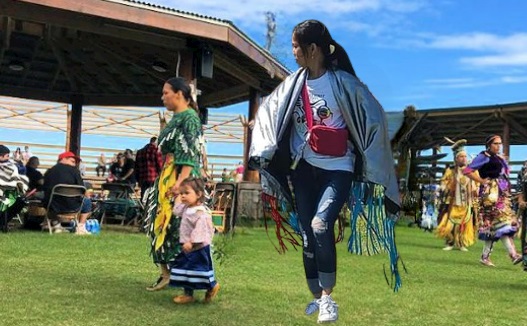
811 Oceanview Drive
Degrau, NL. A0N 1T1
Email: benoit1stnation@gmail.com
Band Office: 709-272-2085
 |
| L'nui'sin |
Koju’a
The Koju’a is the most unique social dance that has survived to this day. And would traditional occur at celebrations such as weddings or other community gatherings. The dance would complete each celebration. The energetic movements test the dancers’ strength and endurance, especially during a competition. Men and women dance in a circle, and sometimes the men leave the inner circle and dance outside in a livelier manner. The direction of the circle traditionally for Mi’kmaq dances was counter-clockwise. There are also two different koju’a dance steps. One is for dancing around in a circle; the other is a side step, and there is a special song that goes with it. Today, Koju’a competitions might be part of a special cultural event, or they might be danced at powwows as a Mi’kmaw dance.
Neskawet
One person called the Neskawet a “war dance,” but it was far more than that. This formal dance graced many ceremonial occasions. The village’s men gathered in a wikuom. After dinner the villagers smoked a pipe. The guest of honour then presented a long speech that commended his host’s ancestors and hunting skills. After a younger man presented a second speech, the guest of honour began to dance a Neskawet. Advancing with his body strait erect, in measured steps, with his arms a-kimbo. Then he delivers his words, singing and trembling with his whole body, looking before and on each side of him with a steady countenance, sometimes moving with a slow grave pace, and then again with a quick and brisk one.
During ceremonies the girls and women come in, with the oldest at the head of them, who carries in her left hand a great piece of birch bark of the hardest, upon which she strikes as it were a drum; and to that dull sound which the bark returns, they all dance, spinning round on their heels, quivering, with one hand lifted, the other down: other notes they have none, but a guttural loud aspiration of the word Heh! Heh! as often as the old woman strikes her bark-drum. As soon as she ceases striking, they set up a general cry, expressed by Yah! Then, if their dance is approved they begin it again During other Neskawet dances, each keptin took a turn dancing and chanting, doing a step with their hands behind their backs and bodies leaning forward. They danced around the circle, accented their movement when they passed another chief and said “Neh”. At the end, everyone shouted “Eh” Snake or Serpent Dance
The circle of dancers moved first to the right three times around the head man. The dancers then turned their backs to the head man and repeated the revolution three times; next the two sets turned their backs to one another and again moved thrice around the circle; finally, in the same position, they reversed the direction of the motion and move backward around the circle three times. This figure was thus completed in four positions and 12 revolutions, and, according to Newell Glode, signified the rattlesnake waking from his winter sleep
The head man now left the circle through the space made for him, simulating a serpent coming from its hole; he led the dancers around the field, making many snake-like twistings and turnings. In one hand he held a horn filled with shot or small pebbles; with this he rattled the time for the step and the song of the other dancers. After they had advanced some distance, the last dancer remained stationary and the others moved around the leader in a constantly narrowing circle until all were closely coiled around him. The head man then reversed the direction of the motion and the dancers came out of the circle in line as before. This represented the coiling and uncoiling of the rattlesnake.
The head dancer then led the line back to the centre of the circle. The dancers dropped away one by one until the leader chanted and danced alone in the centre.
Medicine Dances
People would perform a special dance to receive medicine from the medicine man. Mi’kmaq took a certain medicine twice a year, in the spring and fall, to keep negative spirits away. The medicine’s formula has remained secret, but some sources have said people would dance around the medicine itself to ward off the bad spirits.
Benoit First Nation - Penwaaq L’nu’k
|
|
Website Copyright © Benoit First Nation